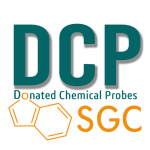TP-004
TP-004 : Inhibitor of METAP2
Structure
In Cells
In Model Organisms
Probe TP-004 is in the process of SERP review.
Please continue to check back for new reviews and commentary.
SERP ratings and comments
SERP Ratings
SERP Comments:
The probe was evaluated against a panel of 100 GPCR receptors, ion channels, transporters and enzymes, (referred to as the Ricerca Comprehensive Pharmacological Profile screen) and 26 proteases and displayed inhibition ≤ 50% at 10 µM suggesting a useful degree of selectivity; however, the specific molecular targets were not disclosed. The probe has been counter-screened against the other human methionine aminopeptidase MetAP1 (IC50 = 18 µM; doi.org/10.1124/jpet.119.259028) providing 900-fold isoform selectivity. Given the high potency of the probe against MetAP2 and the nearly 3-orders of magnitude selectivity against MetAP1 and a panel of 126 other targets, the probe is possesses a promising level of selectivity. Further details of the specific enzymes evaluated would be useful to affirm the selectivity. It would also be useful to screen against a large panel of metalloenzymes since the probe directly coordinates with both metal atoms in the active site of MetAP2.
The probe is reported to possess an EC50 of 15 nM (doi.org/10.1016/j.bmcl.2016.04.073) and 26 nM (doi.org/10.1124/jpet.119.259028) in a cellular assay (HUVEC cells) that measures accumulation of N-Met 14-3-3g, which is a client protein of MetAP. The high cellular potency is consistent with the strong enzyme inhibition in the cell-free biochemical assay.
The probe shows almost linear dose-response relationship in vivo with 3, 10, 30 and 100 mg/kg doses displaying 1%, 5%, 11% and 22% weight loss at the 2 week timepoints. Target engagement studies measuring accumulation of N-Met 14-3-3g in adipose tissue also showed clear dose-response relationships.
(last updated: 2 Jun 2020 )
SERP Ratings
SERP Comments:
My reasons for concern in recommending this probe are that much of the data reported for this compound is not publicly available. For example, a selectivity profile of >1000 is reported in this form for MetAP2 over MetAP1, but no mention of MetAP1 data is made in the Bioorg. Med. Chem. Lett. paper, nor in the associated patent. Western blots to show target engagement in HUVEC cells are not depicted anywhere, so we must simply “believe” the authors. While I have no reason not to believe them, I would feel more comfortable giving three (or more) stars to a probe where the data is available for all to see. Because I don’t give a 3 star recommendation for cells, I also don’t give it for in vivo work. Furthermore, no on-target activity was demonstrated in animals other than the expected phenotype (weight loss). One last note that goes along this line of thinking: It appears as if an error has been made in reporting the IC50 value when using Cobalt as a metal. In the patent, a pIC50 value of 7.8 for compound 413 (which is TP-004) is listed. A pIC50 value of 7.8 equates to an IC50 value of 16 nM, but 31 nM is reported in this form.
(last updated: 30 Jul 2020 )
